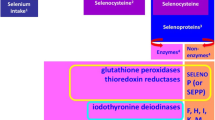Summary
□Basis: Selenium is an essential trace element, which is incorporated as selenocysteine (secys) into specific proteins in a regulated fashion. In the presence of a hairpin loop structure within the 3′ untranslated region of the mRNA the opal stop codon UGA is coding for selenocysteine. Selenoprotein functions are dependent on secys incorporation. Members of the family of deiodinases as well as the family of glutathione peroxidases, selenoprotein P and thioredoxin reductase are selenoproteins.
□Discussion: Bone, the intestine and the thyroid rely on antioxidant systems against potential cell and DNA damage through endogenous and environmental peroxides and reactive oxygen species (ROS) potentially promoting inflammation and tumorigenesis. Optimized cell defense through antioxidant selenoproteins requires optimal selenium supplementation of the organism. We have analyzed the expression of selenoproteins in these tissues, thus providing molecular tools to further elucidate optimal selenium supply on a cellular level.
□Conclusion: Clinical intervention studies that focus on the development of disease must confirm the relevance of optimized selenium supply for the pathogenesis, prevention and therapy of metabolic bone disease as well as chronic (autoimmune) inflammation and tumorigenesis in the thyroid and intestine.
Similar content being viewed by others
Literatur
Berry, M. J., L. Banu, J. W. Harney, P. R. Larsen: Functional characterization of the eukaryotic SECIS elements which direct selenocysteine insertion at UGA codons. EMBO J. 12 (1993), 3315–3322.
Brigelius Flohé, R., K. D. Aumann, H. Blocker, G. Gross, M. Kiess, K. D. Kloppel, M. Maiorino, A. Roveri, R. Schuckelt, F. Ursini, E. Wingender, L. Flohé: Phospholipid-hydroxyperoxide glutathione peroxidase. Genomic DNA, cDNA and deduced amino acid sequence. J. Biol. Chem. 269 (1994), 7342–7348.
Burk, R. F., K. E. Hill: Selenoprotein P. A selenium-rich extracellular glycoprotein. J. Nutr. 124 (1994), 1891–1897.
Clark, L. C., G. F. Combs, B. W. Turnbull, E. H. Slate, D. C. Chalker, J. Chow, L. S. Davis, L. A. Glover, G. F. Graham, E. G. Gross, A. Krongrad, J. L. Lesher, H. K. Park, B. B. Sanders, C. L. Smith, J. R. Taylor, for the Prevention of Cancer Study Group: Effects of selenium supplementation for cancer prevention in patients with carcinoma of the skin. J. Amer. Med. Ass. 276 (1996), 1957–1963.
Chu, F. F., J. H. Doroshow, R. S. Esworthy: Expression, characterization and tissue distribution of a new cellular selenium-dependent glutathione peroxidase, GSHPx-GI. J. biol. Chem. 268 (1993), 2571–2576.
Contempré, B., J. E. Dumont, J.-F. Denef, M.-C. Many: Effects of selenium deficiency on thyroid necrosis, fibrosis and proliferation: a possible role in myxoedematous cretinism. Europ. J. Endocr. 133 (1995), 99–109.
Contempré, B., O. Le Moine, J. E. Dumont, J.-F. Denef, M.-C. Many: Selenium deficiency and thyroid fibrosis. A key role for macrophages and transforming growth factor b (TGFb). Molec. Cell. Endocr. 124 (1996), 7–15.
Dreher, I., C. Schmutzler, F. Jakob, J. Köhrle: Expression of Selenoproteins in various tissues and cell lines. Trace Elem. Biol. Med. 11 (1997), 83–91.
Gadeska, A., F. Howie: Cloning of the human thioredoxin reductase gene. FEBS Lett. 373 (1995), 5–9.
Köhrle, J., M. Oertel, C. Hoang-Vu, F. Schnieders, G. Brabant: Type 15′-deiodinase — a marker for the differentiated thyroid carcinoma? Exp. clin. Endocr. 101 (1993), 60–72.
Köhrle, J.: Thyroid hormone deiodinases — a selenoenzyme family acting as gate keepers to thyroid hormone action. Thyroid 23 (1996), 17–30.
Mörk, H., I. Dreher, B. Lex, J. Köhrle, F. Jakob: Expression von Selenoproteinen im Gastrointestinaltrakt. Proc. 12. Jahrestagung der Gesellschaft für Mineralstoffe und Spurenelemente, Würzburg 1996, im Druck.
Oster, O.: Zum Selenstatus in der Bundesrepublik Deutschland. Universitätsverlag, Jena — Frankfurt — Budapest — Den Haag — Kairo — Mailand — Moskau — Sennwald — Wien 1992.
Sen, C. K., L. Packer: Antioxidant and redox regulation of gene transcription. FASEBJ. 10 (1996), 709–720.
Ursini F., M. Maiorino, R. Brigelius-Flohé, K. D. Aumann, A. Roveri, D. Schomburg, L. Flohé: Diversity of glutathione peroxidases. Meth. Enzymol. 252 (1995), 38–53.
Author information
Authors and Affiliations
Rights and permissions
About this article
Cite this article
Jakob, F., Mörk, H., Schütze, N. et al. Selenoproteine im Knochen, Gastrointestinaltrakt und in der Schilddrüse des Menschen. Med Klin 92 (Suppl 3), 24–26 (1997). https://doi.org/10.1007/BF03041956
Issue Date:
DOI: https://doi.org/10.1007/BF03041956




